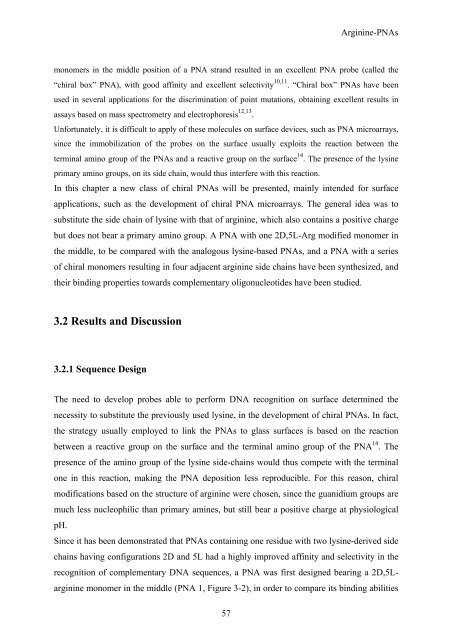View - DSpace UniPR
View - DSpace UniPR
View - DSpace UniPR
You also want an ePaper? Increase the reach of your titles
YUMPU automatically turns print PDFs into web optimized ePapers that Google loves.
Arginine-PNAs<br />
monomers in the middle position of a PNA strand resulted in an excellent PNA probe (called the<br />
“chiral box” PNA), with good affinity and excellent selectivity 10,11 . “Chiral box” PNAs have been<br />
used in several applications for the discrimination of point mutations, obtaining excellent results in<br />
assays based on mass spectrometry and electrophoresis 12,13 .<br />
Unfortunately, it is difficult to apply of these molecules on surface devices, such as PNA microarrays,<br />
since the immobilization of the probes on the surface usually exploits the reaction between the<br />
terminal amino group of the PNAs and a reactive group on the surface 14 . The presence of the lysine<br />
primary amino groups, on its side chain, would thus interfere with this reaction.<br />
In this chapter a new class of chiral PNAs will be presented, mainly intended for surface<br />
applications, such as the development of chiral PNA microarrays. The general idea was to<br />
substitute the side chain of lysine with that of arginine, which also contains a positive charge<br />
but does not bear a primary amino group. A PNA with one 2D,5L-Arg modified monomer in<br />
the middle, to be compared with the analogous lysine-based PNAs, and a PNA with a series<br />
of chiral monomers resulting in four adjacent arginine side chains have been synthesized, and<br />
their binding properties towards complementary oligonucleotides have been studied.<br />
3.2 Results and Discussion<br />
3.2.1 Sequence Design<br />
The need to develop probes able to perform DNA recognition on surface determined the<br />
necessity to substitute the previously used lysine, in the development of chiral PNAs. In fact,<br />
the strategy usually employed to link the PNAs to glass surfaces is based on the reaction<br />
between a reactive group on the surface and the terminal amino group of the PNA 14 . The<br />
presence of the amino group of the lysine side-chains would thus compete with the terminal<br />
one in this reaction, making the PNA deposition less reproducible. For this reason, chiral<br />
modifications based on the structure of arginine were chosen, since the guanidium groups are<br />
much less nucleophilic than primary amines, but still bear a positive charge at physiological<br />
pH.<br />
Since it has been demonstrated that PNAs containing one residue with two lysine-derived side<br />
chains having configurations 2D and 5L had a highly improved affinity and selectivity in the<br />
recognition of complementary DNA sequences, a PNA was first designed bearing a 2D,5Larginine<br />
monomer in the middle (PNA 1, Figure 3-2), in order to compare its binding abilities<br />
57
















